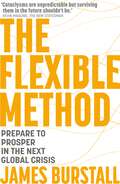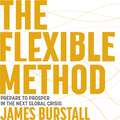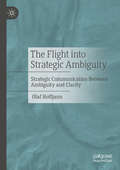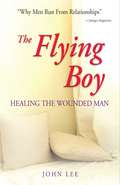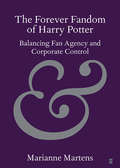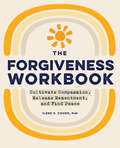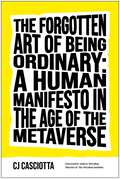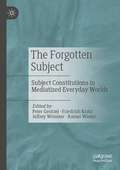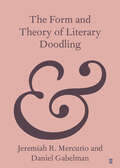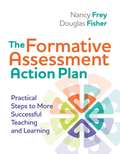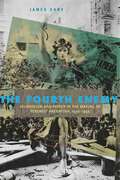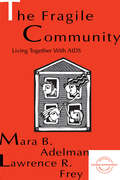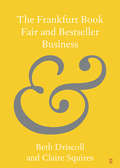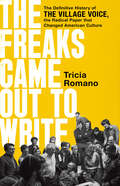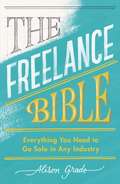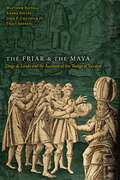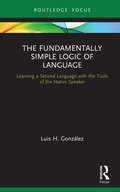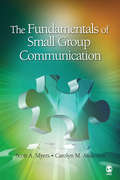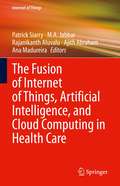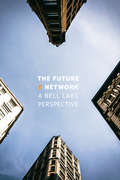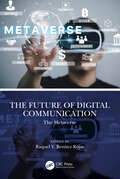- Table View
- List View
The Flexible Method: Prepare To Prosper In The Next Global Crisis
by James BurstallJames Burstall runs one of the most successful TV production companies in the UK. But during his tenure at Argonon he has had to deal with a variety of existential crises. Through them all, he's managed to guide his team out the other side successfully. Whether it's been the credit crunch or terror attacks. Recessions. Natural disasters. Pandemics. The TV industry has felt the strain of these recurring events like all of us. And each time, James has put strategies in place in order to be prepared for the next time something like this happens: because it will happen again.Now you can be prepared as well.In 16 concise lessons, hard won from real-world experience, this book uses practical examples to demonstrate how we can turn disasters into opportunities. Though painful, shock events can actually be good for us. It is possible to turn venom into rocket fuel! We can survive crises and thrive.Rather than a dry 'to-do' list, this is a recognised thought leader's candid, personal account of steering a company through painful decisions, which resulted in successes that astonished the TV industry. It also highlights the experience of leaders in a range of industries including health, fitness, hospitality, travel, events and non-profit organisations. And despite the subject matter, the tone and message of his lessons are ultimately optimistic and uplifting as he takes readers on a journey through the darkest depths of crises to emerge fitter and stronger.
The Flexible Method: Prepare To Prosper In The Next Global Crisis
by James BurstallDisasters are inevitable but you don't have to face them unprepared. This audiobook shows what we can do to futureproof our organisations against the next global crisis.James Burstall runs one of the most successful TV production companies in the UK. But during his tenure at Argonon he has had to deal with a variety of existential crises. Through them all, he's managed to guide his team out the other side successfully. Whether it's been the credit crunch or terror attacks. Recessions. Natural disasters. Pandemics. The TV industry has felt the strain of these recurring events like all of us. And each time, James has put strategies in place in order to be prepared for the next time something like this happens: because it will happen again.Now you can be prepared as well.In 16 concise lessons, hard won from real-world experience, this audiobook uses practical examples to demonstrate how we can turn disasters into opportunities. Though painful, shock events can actually be good for us. It is possible to turn venom into rocket fuel! We can survive crises and thrive.Rather than a dry 'to-do' list, this is a recognised thought leader's candid, personal account of steering a company through painful decisions, which resulted in successes that astonished the TV industry. It also highlights the experience of leaders in a range of industries including health, fitness, hospitality, travel, events and non-profit organisations. And despite the subject matter, the tone and message of his lessons are ultimately optimistic and uplifting as he takes listeners on a journey through the darkest depths of crises to emerge fitter and stronger.(P) 2023 Hodder & Stoughton Limited
The Flight into Strategic Ambiguity: Strategic Communication Between Ambiguity and Clarity
by Olaf HoffjannThis book analyses how and why advertising, PR, and corporate and political communication make use of strategic ambiguity. This special quality of vagueness allows companies to talk about the relevance of ESG or governments to promise stability and prosperity without fully committing themselves, disappointing no one and securing every freedom. This book describes in detail the diverse practices of ambiguous strategic communication – and its opposite, strategic clarity – with many examples. For academics, it offers a detailed framework for describing and researching strategic ambiguity. For PR practitioners, it provides a toolbox for the use of strategic ambiguity. Lastly, it provides journalists with a means of recognizing and criticizing questionable strategic ambiguity. This book is a translation of the original German edition “Die Flucht in die Ambiguität”. The translation was done with the help of an artificial intelligence machine translation tool. A subsequent human revision was done primarily in terms of content, so that the book will read stylistically differently from a conventional translation.
The Flood of 2013
by Naheed Nenshi HeraldThe Flood of 2013 chronicles an unforgettable summer of angry rivers, unprecedented flooding and undeniable human spirit. This book looks at how the disaster irrevocably changed southern Alberta and its people. In the face of disaster, Albertans showed their true grit and rose above adversity-just like their ancestors did for generations before them.The flood began in southern Alberta on June 20 and led to four deaths, billions of dollars in damage and more than 100,000 people fleeing their homes to escape raging waters. More than eighty Herald journalists-photographers, writers, editors, videographers, researchers and digital producers-became involved in narrating the tale of the flood. Using their words and images, this stunning volume captures not only the devastation and destruction of the flood but also the emergence of heroes and heartfelt moments. Neighbours helped neighbours. Strangers helped strangers. And Albertans vowed to recover, come hell or high water.
The Flying Boy: Healing the Wounded Man
by John LeeA record of one man's journey to find his "true masculinity" and his way out of co-dependent and addictive relationships. It's a book for all men and women who grew up in dysfunctional families and are now ready for some fresh insights into their past and their pain. It's a story about feelings - losing them, finding them and finally expressing them. Here you will find people you know; will discover a way out of the pain and see that it really is OK to express yourself without fear. The book is about grieving, a very misunderstood process often confused with self-pity. Open the doors to understanding - men will understand themselves and each other, and women will more deeply understand men, learn how to be with wounded men and still take care of themselves.
The Forever Fandom of Harry Potter: Balancing Fan Agency and Corporate Control (Elements in Publishing and Book Culture)
by Marianne MartensHarry Potter fans contribute their immaterial and affective labor in multiple arenas: as peer-to-peer marketers via fan sites and social media; as participants in amateur fan festivals; or as activists for social change. Fans' participation in the Harry Potter universe has contributed to its success. This Element examines how fans' labor might continue to support the franchise for future readers. Starting with the context and theoretical frameworks that support a multidimensional analysis of the Harry Potter fan experience, this Element examines tensions between fans and Warner Bros., as fan participation tests the limits of corporate control.
The Forgiveness Workbook: Cultivate Compassion, Release Resentment, and Find Peace
by Ilene S. Cohen PhDLet go and learn to forgive Forgiveness doesn't mean forgetting what happened or returning to the way things were before: it means choosing to release resentment and live a freer, happier life. For anyone seeking a starting point on the path to forgiving themselves or someone else, The Forgiveness Workbook can light the way. This simple and straightforward guide gets right to the heart of what forgiveness means and why it can feel so hard to do. Explore all the ways that practicing empathy and forgiveness encourages healing and growth, with activities, quizzes, and guided prompts that offer support for every step of the process. Go deeper than other personal growth books with: Six steps to moving on—Find a road map of what to expect along the journey, with chapters that clearly break down the six stages of forgiveness. Focus on self-empowerment—Learn how a willingness to forgive helps build resilience, healthier relationships, and a stronger sense of self. The science of forgiveness—Understand what happens in the brain and body when you hold in negative feelings—and the benefits of leaving them behind. Find strategies for releasing blame and moving on with The Forgiveness Workbook.
The Forgotten Art of Being Ordinary: A Human Manifesto in the Age of the Metaverse
by CJ CasciottaWe&’re addicted to our devices. Our kids are too. None of us seem to be better for it. We all know this, but what can we do practically to become less isolated, polarized, and disconnected? This book answers that question with a bold idea: In an age of personal brands and artificial intelligence, perhaps it&’s time to relearn the forgotten art of being ordinary. In his follow-up to Get Weird, writer and media producer, CJ Casciotta, outlines nine practical solutions and illuminates a better way to live in a culture addicted to media technology, a lifeboat for anyone who feels like they&’re drowning in a sea of digital noise. This is a book for those who are tired of feeling like technology owns them, their children, their politics, and their livelihood, a hopeful and realistic game plan for navigating the 21st century mindfully without losing their souls. The future of our society will depend on the choices we make right now when it comes to our communication methods. It&’s a crisis as urgent as climate change, yet far fewer people are talking about it. The Forgotten Art of Being Ordinary will give you the language you&’ve been looking for to start changing the conversation.
The Forgotten Subject: Subject Constitutions in Mediatized Everyday Worlds
by Jeffrey Wimmer Friedrich Krotz Rainer Winter Peter GentzelThe volume provides a critical inventory of existing concepts of the subject in communication studies research. In addition, concepts are developed in order to be able to analyze subjectivity in the context of current theoretical debates (including media sociology, cultural studies, psychoanalysis, practice theory, science and technology studies) as well as social, cultural and technical developments (including digitalization, mediatization, mobility and networking). Since subject conceptions are of central importance for any communication and media analyses, the volume fills a central gap in communication and media studies.
The Form and Theory of Literary Doodling (Elements in Publishing and Book Culture)
by Jeremiah R. Mercurio Daniel GabelmanThis Element investigates the phenomenon of literary doodling—the making of playful verbal and visual creations by professional authors while engaged in another activity. The first part focuses on defining the form and structure of doodles, comparing and contrasting them with adjacent genres such as sketches, caricatures, and illustrations. The second part explores the modality of doodling, examining doodles through the lenses of spectrality, liminality, and play. Drawing on a wide range of theories and backed up with numerous close readings, the Element argues that doodles, despite their apparent triviality, provide valuable insights into the creative processes, authorial habits, and finished works of literary doodlers. Ultimately, this study aims to legitimise doodles as worthy of serious critical attention, demonstrating how they trouble the meaning of texts, introduce semantic flexibility into literary works and their reception, and rejuvenate the joy of readerly discovery.
The Formative Assessment Action Plan: Practical Steps to More Successful Teaching and Learning (Professional Development)
by Douglas Fisher Nancy FreyWinner of a 2012 Distinguished Achievement Award from the Association of Educational Publishers! Join Nancy Frey and Douglas Fisher as they outline a clear-cut, realistic, and rewarding approach to formative assessment. They explain how four discrete steps work in tandem to create a seamless, comprehensive formative assessment system one that has no beginning and no end. This ongoing approach enhances an active give-and-take relationship between teachers and students to promote learning. <p><p> Dozens of real-life scenarios demonstrate how to apply these steps in your classroom, always focusing on the presence or absence of student learning to guide the action. By enabling teachers and students alike to see more clearly what they need to do for learning to be successful, this approach builds students' competence, confidence, and understanding. <p><p> No matter what grade level you teach, The Formative Assessment Action Plan will help you make better use of assessment data so you can more quickly adjust instruction to keep every student on the path to success.
The Fourth Enemy: Journalism and Power in the Making of Peronist Argentina, 1930–1955
by James CaneThe rise of Juan Perón to power in Argentina in the 1940s is one of the most studied subjects in Argentine history. But no book before this has examined the role the Peronists’ struggle with the major commercial newspaper media played in the movement’s evolution, or what the resulting transformation of this industry meant for the normative and practical redefinition of the relationships among state, press, and public. In The Fourth Enemy, James Cane traces the violent confrontations, backroom deals, and legal actions that allowed Juan Domingo Perón to convert Latin America’s most vibrant commercial newspaper industry into the region’s largest state-dominated media empire. An interdisciplinary study drawing from labor history, communication studies, and the history of ideas, this book shows how decades-old conflicts within the newspaper industry helped shape not just the social crises from which Peronism emerged, but the very nature of the Peronist experiment as well.
The Fourth Enemy: Journalism and Power in the Making of Peronist Argentina, 1930–1955
by James CaneThe rise of Juan Perón to power in Argentina in the 1940s is one of the most studied subjects in Argentine history. But no book before this has examined the role the Peronists’ struggle with the major commercial newspaper media played in the movement’s evolution, or what the resulting transformation of this industry meant for the normative and practical redefinition of the relationships among state, press, and public. In The Fourth Enemy, James Cane traces the violent confrontations, backroom deals, and legal actions that allowed Juan Domingo Perón to convert Latin America’s most vibrant commercial newspaper industry into the region’s largest state-dominated media empire. An interdisciplinary study drawing from labor history, communication studies, and the history of ideas, this book shows how decades-old conflicts within the newspaper industry helped shape not just the social crises from which Peronism emerged, but the very nature of the Peronist experiment as well.
The Fragile Community: Living Together With Aids (Everyday Communication Ser.)
by Larry R. Frey Mara B. AdelmanThis book examines the concept of "community," focusing on how communication practices help manage the tensions of creating and sustaining everyday communal life amidst the crisis of human loss. While acknowledging how the contradictory and inconsistent nature of human relationships inevitably affects community, this intimate and compelling text shows how community is created and sustained in concrete communication practices. The authors explore these ideas at Bonaventure House, an award-winning residential facility for people with AIDS, where the web of social relationships and the demands of a life-threatening illness intersect in complex ways. Facing a life-threatening illness can defy meaningful social connections, but it can also inspire such ties, sometimes in ways that elude us in the course of daily life. By understanding how collective communication practices help residents forge a sense of community out of the fragility and chaos of living together with AIDS, we are able to better understand how communication is inexorably intertwined with the formation of community in other environments. Based on seven years of ethnographic research including participant-observation, in-depth interviews, and questionnaires, this book weaves together narratives and visual images with conceptual analysis to uncover the ongoing oppositional forces of community life, and to show how both mundane and profound communication processes ameliorate these tensions, and thereby sustain this fragile community. Because the average length of stay for a resident is seven months -- in which time he or she moves from being a newcomer to a community member to someone the community remembers -- the text reflects this short, but crystallized life, starting with the day a new resident opens the door to the day he or she passes away. The writing is rich -- intimate, engaging, personal, compelling, and vivid. The stories told discuss such deeply personal topics as the dilemmas of romantic relationships in a context fraught with many perils; issues of power, authority, and control that enable and constrain social life; and communicative practices that help residents cope with bereavement over the loss of others as well as their own impending deaths. The text concludes by examining the lessons learned from Bonaventure House about creating and sustaining a health community, and serves as an inspiration for strengthening interpersonal relationships and communities in other environments.
The Frankfurt Book Fair and Bestseller Business (Elements in Publishing and Book Culture)
by Beth Driscoll Claire SquiresThe Frankfurt Book Fair is the leading global industry venue for rights sales, facilitating business-to-buzzness deals and international networks. In this Element, we pursue an Ullapoolist approach to excavate beneath the production of bestsellers at the Fair. Our investigation involved three consecutive years of fieldwork (2017–2019) including interviews and autoethnographic, arts-informed interventions. The Element argues that buzz at the Fair exists in two states: as market-ready media reports and partial, lived experiences linked to mood. The physical structures and absences of the Fair enact its power relations and direct the flow of books and buzz. Further, the Fair is not only a site for commercial exchange but a carnival of sorts, marked by disruptive historical events and problematic socio-political dynamics. Key themes emerging from the Element are the presence of excess, the pseudo(neo)liberal self-satisfaction of book culture, and the interplay of optimism and pessimism in contemporary publishing.
The Freaks Came Out to Write: The Definitive History of the Village Voice, the Radical Paper That Changed American Culture
by Tricia RomanoA rollicking history of America's most iconic weekly newspaper told through the voices of its legendary writers, editors, and photographers. You either were there or you wanted to be. A defining New York City institution co-founded by Norman Mailer, The Village Voice was the first newspaper to cover hip-hop, the avant-garde art scene, and Off-Broadway with gravitas. It reported on the AIDS crisis with urgency and seriousness when other papers dismissed it as a gay disease. In 1979, the Voice&’s Wayne Barrett uncovered Donald Trump as a corrupt con artist before anyone else was paying attention. It invented new forms of criticism and storytelling and revolutionized journalism, spawning hundreds of copycats. With more than 200 interviews, including two-time Pulitzer Prize winner, Colson Whitehead, cultural critic Greg Tate, gossip columnist Michael Musto, and feminist writers Vivian Gornick and Susan Brownmiller, former Voice writer Tricia Romano pays homage to the paper that saved NYC landmarks from destruction and exposed corrupt landlords and judges. With interviews featuring post-punk band, Blondie, sportscaster Bob Costas, and drummer Max Weinberg, of Bruce Springsteen&’s E Street Band, in this definitive oral history, Romano tells the story of journalism, New York City and American culture—and the most famous alt-weekly of all time.FINALIST FOR 2024 NATIONAL BOOK CRITICS CHOICE AWARDS FINALIST FOR 2025 GOTHAM BOOK PRIZE LISTED IN BEST BOOKS OF 2024 BY NEW YORK MAGAZINE (VULTURE), THE NEW YORKER, LITHUB, AND CHICAGO PUBLIC LIBRARY
The Free Mind: Finding Clarity in a Digitally Distracted World
by Dza Kilung RinpocheReduce the distractions, clutter, and anxiety of your digital lifestyle and achieve inner and outer harmony with mind training practices, meditations, and advice from a Tibetan Buddhist master.This book offers a refreshing approach to understanding the role of digital technology in our world and how we can better manage our relationship to it. Our engagement with digital devices connects us to people and ideas, but it also causes anxiety, distraction, imbalance, and suffering. Rather than a digital detox, we can train our minds to leverage our negative habits and digital temptations to deal with life more effectively, improve our attention span, reduce mental fatigue, and deepen our happiness.Dza Kilung Rinpoche, a respected contemporary Tibetan Buddhist teacher and author of The Relaxed Mind, skillfully addresses these widespread issues in modern life geared toward a wide audience. In twelve short chapters, he offers straightforward strategies and tools to clear away the distractive clutter that prevents us from living fully and with clarity. The book also explores deeper issues like the nature of wisdom, question of karma, and importance of lovingkindness and compassion.The practices and meditations in this book will appeal to anyone who suffers from a distracted &“monkey mind.&” By calming our minds, we can clearly see the sources of our inner and outer problems and begin to work on them for the benefit of ourselves, others, and the earth.
The Freelance Bible: Everything You Need to Go Solo in Any Industry
by Alison Grade'Finally! The book that millions of people have been crying out for. An empowering guide of how to use your work to achieve independence, inspiration and - crucially - balance' Bruce Daisley, author of The Joy of Work and VP,TwitterYou want to go freelance. You want to make your career work for you, on your terms and determined by your own definition of success. You want autonomy, flexibility and variety.But where do you start?In The Freelance Bible, award-winning entrepreneur and freelancer, Alison Grade, guides you through absolutely everything that you need to know to start your successful self-employed life.Starting from day one, she will help you develop your personal brand, pick up the financial essentials, grow your client base, manage your work-life balance, negotiate deals and value your time as you become more established. This is your complete guide to turning your talent into a fulfilling and sustainable career.'Alison strikes an excellent and inspirational balance; sharing tips and advice that help you work out how to be secure in insecurity and ace the journey to becoming a freelancer' Alex Mahon CEO, Channel 4
The Friar and the Maya: Diego de Landa and the Account of the Things of Yucatan
by Matthew Restall Traci Ardren John F. Chuchiak Amara SolariThe Friar and the Maya offers a full study and new translation of the Relación de las Cosas de Yucatán (Account of the Things of Yucatan) by a unique set of eminent scholars, created by them over more than a decade from the original manuscript held by the Real Academia de la Historia in Madrid. This critical and careful reading of the Account is long overdue in Maya studies and will forever change how this seminal text is understood and used. For generations, scholars used (and misused) the Account as the sole eyewitness insight into an ancient civilization. It is credited to the sixteenth-century Spanish Franciscan, monastic inquisitor, and bishop Diego de Landa, whose legacy is complex and contested. His extensive writings on Maya culture and history were lost in the seventeenth century, save for the fragment that is the Account, discovered in the nineteenth century, and accorded near-biblical status in the twentieth as the first “ethnography” of the Maya. However, the Account is not authored by Landa alone; it is a compilation of excerpts, many from writings by other Spaniards—a significant revelation made here for the first time. This new translation accurately reflects the style and vocabulary of the original manuscript. It is augmented by a monograph—comprising an introductory chapter, seven essays, and hundreds of notes—that describes, explains, and analyzes the life and times of Diego de Landa, the Account, and the role it has played in the development of modern Maya studies. The Friar and the Maya is an innovative presentation on an important and previously misunderstood primary source.
The Fundamentally Simple Logic of Language: Learning a Second Language with the Tools of the Native Speaker
by Luis H. GonzálezThe Fundamentally Simple Logic of Language: Learning a Second Language with the Tools of the Native Speaker presents a data-driven approach to understanding how native speakers do not use subject and direct object to process language. Native speakers know who does what in a sentence by applying intuitively two simple inferences that are argued to be part of universal grammar. The book explains and exemplifies these two inferences throughout. These two inferences explain the native speaker’s ease of acquisition and use, and answer difficult questions for linguistics (transitivity, case, semantic roles) in such a way that undergraduate students and second language learners can understand these concepts and apply them to their own language acquisition. While Spanish is used as the primary example, the theory can be applied to many other languages. This book will appeal to teachers and learners of any second language, as well as linguists interested in second language acquisition, in second language teaching, and in argument structure.
The Fundamentals of Small Group Communication: Myers: The Fundamentals Of Small Group Communication + Sunwolf: Peer Groups
by Scott A. Myers Carolyn M. AndersonThe Fundamentals of Small Group Communication provides readers with the fundamentals they need to become functional and productive members of any small group. Readers are introduced to the fundamental issues faced by all small groups (such as socialization, development, ethics, diversity) and the procedures utilized by effective small groups (for example, task accomplishment, decision making, climate). With a focus on the individual group member, this textbook encourages readers to reflect on how their communication behaviors (e.g., communication traits, verbal and nonverbal communication, listening style) and practices (e.g., their leadership style, their conflict management style) contribute to their current small group experiences.
The Fundamentals of Small Group Communication: Myers: The Fundamentals Of Small Group Communication + Sunwolf: Peer Groups
by Scott A. Myers Carolyn M. AndersonThe Fundamentals of Small Group Communication provides readers with the fundamentals they need to become functional and productive members of any small group. Readers are introduced to the fundamental issues faced by all small groups (such as socialization, development, ethics, diversity) and the procedures utilized by effective small groups (for example, task accomplishment, decision making, climate). With a focus on the individual group member, this textbook encourages readers to reflect on how their communication behaviors (e.g., communication traits, verbal and nonverbal communication, listening style) and practices (e.g., their leadership style, their conflict management style) contribute to their current small group experiences.
The Fusion of Internet of Things, Artificial Intelligence, and Cloud Computing in Health Care (Internet of Things)
by Ajith Abraham Patrick Siarry Ana Madureira M. A. Jabbar Rajanikanth AluvaluThis book reviews the convergence technologies like cloud computing, artificial intelligence (AI) and Internet of Things (IoT) in healthcare and how they can help all stakeholders in the healthcare sector. The book is a proficient guide on the relationship between AI, IoT and healthcare and gives examples into how IoT is changing all aspects of the healthcare industry. Topics include remote patient monitoring, the telemedicine ecosystem, pattern imaging analytics using AI, disease identification and diagnosis using AI, robotic surgery, prediction of epidemic outbreaks, and more. The contributors include applications and case studies across all areas of computational intelligence in healthcare data. The authors also include workflow in IoT-enabled healthcare technologies and explore privacy and security issues in healthcare-based IoT.
The Future X Network: A Bell Labs Perspective
by Marcus K. WeldonWe are at the dawn of an era in networking that has the potential to define a new phase of human existence. This era will be shaped by the digitization and connection of everything and everyone with the goal of automating much of life, effectively creating time by maximizing the efficiency of everything we do and augmenting our intelligence with knowledge that expedites and optimizes decision-making and everyday routines and processes.The Future X Network: A Bell Labs Perspective outlines how Bell Labs sees this future unfolding and the key technological breakthroughs needed at both the architectural and systems levels. Each chapter of the book is dedicated to a major area of change and the network and systems innovation required to realize the technological revolution that will be the essential product of this new digital future.
The Future of Digital Communication: The Metaverse
by Raquel V. Benítez RojasThis collection of essays explores the present and future of digital communication through a range of interdisciplinary approaches, all of which focus on the so-called metaverse. The metaverse is a combination of multiple elements of technology – including virtual reality, augmented reality, and video – where users "live" within a digital universe. The vision for this new universe is that its users can work, play, and stay connected with friends through everything. Such a vision is hinted at in existing phenomena such as online game universes.
